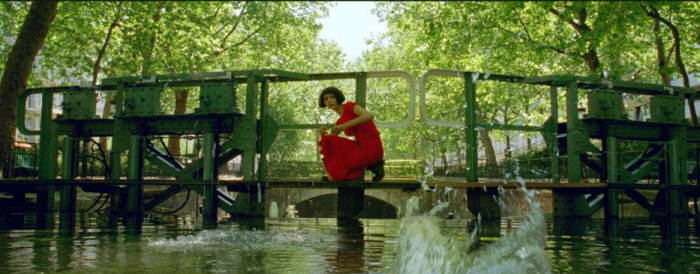Cinematography of Amélie
Alexander S. Peak
Also available in .txt and .pdf.
5 November 2002
The cinematography of Le Fabuleux Destin d’Amélie Poulain was uniquely interesting; while not detracting from the integrity of the storyline, it added to the artistic quirkiness of the production, and the overall feeling and direction in which the story takes you. The story opens before the birth of the young female lead character, Amélie. As un-stimulating as that may sound, from this point already the viewer has the distinct notion that this is not going to be your run-of-the-mill movie. It starts by stating unnecessary, unrelated facts with semi-quick shots. This quirky opening sets the stage for the rest of the production, which maintains the same degree of quirkiness throughout.
Some scenes really stick out in one’s mind. One such scene in Amélie consisted of Amélie standing on a bridge, skipping stones across the water. The sky was a bright blue. The water was clear. The scene takes place in a peaceful and tranquil—dare I say serene?—surrounding. The camera moves from behind our protagonist to above her head, and finally to the water in front of her; just as she was bending down to skip her last stone. This shot is beautiful, and the proof is in the last stone, because just as the camera reaches water level, the stone comes skipping directly past the lens of the camera. The result is a smooth, flowing shot, which works quite nicely, given that every visual aspect of the shot (i.e., the water, the skipping stone, etc.) also flows smoothly.
Another scene that evokes the mind’s memory was of Amélie asking herself just how many people were having an orgasm at that very moment, not because of its short yet gratuitous sex scene, but because of the overall quirkiness of the shot visually, and because of the scene’s unexpected conclusion. Amélie is standing above the city, looking down upon it. The question is unexpected, but not unheard of. Suddenly, the shot changes. They show 15-or-so quick shots of various people doing the deed, in their own unique—often unattractive—ways. As the purpose of the shot was not sexual pleasure, but instead, merely a means of proving to the audience that sex was indeed going on, the shots were cut together quickly. Then, the unexpected surprise end to the scene arrives: another shot of Amélie over the city appears, and she now answers her own silly question: “Fifteen,” she responds to herself. The scene was quirky mostly due to its “out-of-placeness,” while, in context to the tone of the production as a whole, it fit right in, and added to the basic direction of the film.
The direction was definitely “different,” for lack of a better word. The scenes were beautiful, and very colorful. “Colorful” can also describe the storyline, which had the tendency for being artful. The camera angles and movements, like in the instance of the stone-skipping scene, flowed in an often unconventional manner, thereby stimulating the feeling of understanding. And, finally, the cinematography in general, which evoked a sense of interest in the world and particularly in the life and interactions of the always interesting Amélie, truly made the production something interesting on which to focus, and to follow, just as we were to follow Amélie through some of the events in her life.

